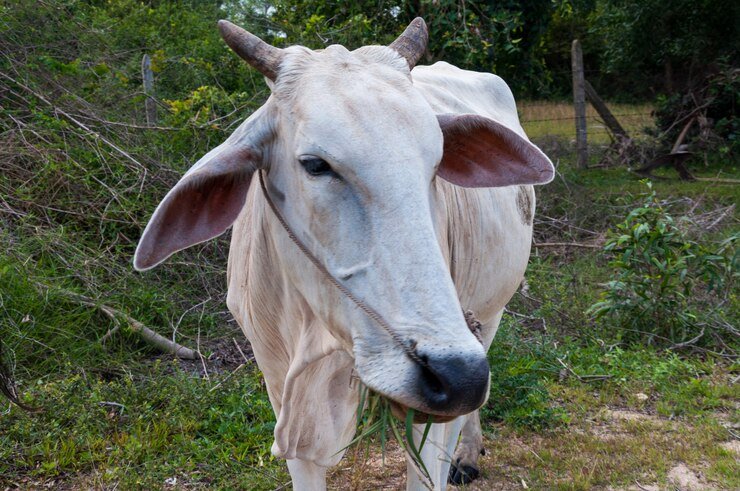India is home to a diverse range of indigenous cow breeds, each adapted to the country’s varied climatic and geographical conditions. These breeds not only contribute significantly to the dairy industry but also play a crucial role in sustainable agriculture. Let's explore five of the most notable cow breeds found in India: Gir, Tharparkar, Red Sindhi, Sahiwal, and Rathi.
1. Gir Breed
The Gir breed, originating from the Gir forests of Gujarat, is one of the most recognized indigenous breeds in India. Known for its high milk yield and resilience, the Gir cow is popular among dairy farmers.
Appearance: Gir cows have a distinctively large hump, loose skin, and a rounded forehead. Their color varies from red to white with a mottled or spotted pattern.
Milk Production: Gir cows are renowned for their milk production, with an average yield of 2000-3000 liters per lactation cycle.
Adaptability: This breed is highly adaptable to various environmental conditions and resistant to common tropical diseases, making it a popular choice among farmers in arid and semi-arid regions.
Significance: Gir cows are known for producing milk with high butterfat content, making their milk particularly rich and suitable for dairy products like ghee and butter.
2. Tharparkar
Originating from the Thar Desert region in Rajasthan, the Tharparkar breed is a hardy breed known for both milk and draught capabilities.
Appearance: Tharparkar cows have a well-built body, predominantly white or grey coat, and medium-sized horns that curve upward.
Milk Production: They have an average lactation yield of about 1800-2200 liters, which is commendable for a breed raised in such harsh conditions.
Adaptability: Tharparkar cows are known for their tolerance to extreme temperatures and drought, making them an ideal choice for regions with limited water and forage availability.
Significance: The Tharparkar breed is valued for its dual-purpose utility; they are also used for fieldwork due to their strength and endurance.
3. Red Sindhi
The Red Sindhi breed, originally from the Sindh province of Pakistan, is popular in India and across Asia due to its adaptability and high milk yield.
Appearance: Red Sindhi cows have a reddish-brown coat, compact body, and medium-sized horns. They are smaller in size but robust and well-adapted to hot climates.
Milk Production: Red Sindhi cows are excellent milk producers, with an average lactation yield ranging between 1500-2500 liters.
Adaptability: This breed is highly resilient, thriving in arid, tropical climates. They also have a strong resistance to common cattle diseases.
Significance: Red Sindhi cows produce milk with high butterfat, making them a valuable addition to dairy farms, especially in hotter climates.
4. Sahiwal
The Sahiwal breed is one of the best dairy breeds in India and is known for its docile temperament and high milk yield.
Appearance: Sahiwal cows have a reddish-brown to dark brown coat, loose skin, and a short, compact build. They possess a unique calm temperament, making them easy to manage.
Milk Production: Sahiwal cows are top milk producers among Indian breeds, with an impressive lactation yield of 2000-3000 liters or more.
Adaptability: They adapt well to both arid and humid climates and have a high tolerance to heat, which reduces stress and maintains their productivity.
Significance: The Sahiwal breed is often crossbred to improve the milk yield of local breeds, making them a valuable resource in genetic improvement programs.
5. Rathi
The Rathi breed originates from Rajasthan and is highly valued for its dairy and draught capabilities.
Appearance: Rathi cows have a distinctive spotted coat, generally white with black or brown spots, and a medium-sized, muscular body.
Milk Production: Known for their steady milk production, Rathi cows have an average lactation yield of around 1500-2000 liters.
Adaptability: Rathi cows are well-suited to the hot and arid conditions of Rajasthan. They have a good tolerance to heat and are resistant to common local diseases.
Significance: The Rathi breed is often used in crossbreeding programs aimed at increasing milk production and enhancing resilience to local conditions.
Conclusion
India’s indigenous cow breeds—Gir, Tharparkar, Red Sindhi, Sahiwal, and Rathi—are integral to the country's dairy and agricultural landscape. They are not only hardy and adapted to India’s diverse climates but also produce milk with unique qualities. Recognizing and promoting these breeds can lead to sustainable dairy farming and the preservation of India's rich cattle biodiversity.

